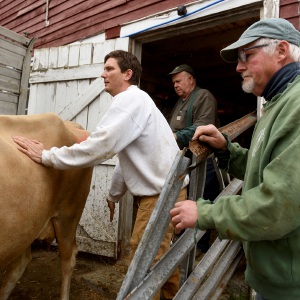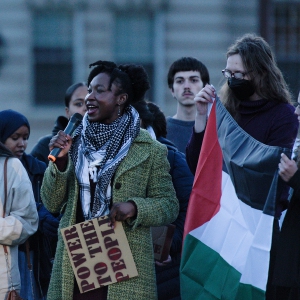Dartmouth becomes hotbed for union activism
| Published: 02-16-2024 7:02 PM |
HANOVER — In 1966, trade workers at Dartmouth got fed up with their bosses picking favorites and pitting employees against each other.
It was time to get organized.
Now, Local 560 of the Service Employees International Union represents more than 500 Dartmouth employees. “I think they all got sick of playing games,” said the branch’s president, Chris Peck, of his forebearers.
These days, as new unions crop up in the Upper Valley writ large — spurred on by labor shortages, stagnant wages and the various hangovers of the pandemic — whether Dartmouth likes it or not, the college has found itself a hotbed of labor activism. It’s been making national news recently: A pair of landmark developments in the history of organizing now call the school’s campus home.
In 2022, grievances over low pay and taxing working conditions led a group of undergraduate students, who are also employees of the college, to become one of the first of its kind to unionize.
The Student Worker Collective at Dartmouth, or the SWCD, secured a $21 minimum wage for student workers, along with better sick leave and annual pay increases. Other employees soon began forming unions of their own, including librarians and graduate students.
Only a couple weeks ago, the National Labor Relations Board handed down a groundbreaking OK to the Dartmouth Men’s Basketball Team, allowing them to vote on becoming the first unionized team in the NCAA. The college has until March 5 to appeal the decision, which it has already said it would do.
The team’s vote, which is expected to be pro-union, is set to take place the same day.
Article continues after...
Yesterday's Most Read Articles
 Herd departs Hartford’s last remaining dairy farm
Herd departs Hartford’s last remaining dairy farm
 At Dartmouth, hundreds protest ongoing war in Gaza and express support for academic freedom
At Dartmouth, hundreds protest ongoing war in Gaza and express support for academic freedom
 Claremont removes former police officer accused of threats from city committees
Claremont removes former police officer accused of threats from city committees
 Over Easy: ‘A breakfast without a newspaper is a horse without a saddle’
Over Easy: ‘A breakfast without a newspaper is a horse without a saddle’
At a gathering of labor groups on campus earlier this week in the Church of Christ, the old guard of unionized non-student workers at Dartmouth College, those of Local 560, celebrated alongside the newly organized.
Ian Scott, a member of SWCD, recalled early negotiations with the college around raising the student workers’ minimum wage.
“Dartmouth at first was like, ‘We don’t have the money there, after they had just made a historic return on the endowment,’ ” Scott said into a microphone from the church’s pulpit. “‘The best we can do is $18.’ We said no. They came back and said, ‘We see you, we hear you, we’ll give you $18.50.’ ”
At Scott’s jab, a particularly loud laugh came from Peck, the president of Local 560.
In a statement, Dartmouth spokesperson Jana Barnello wrote that the college “has a long and proud history of productive relationships with unions on campus, always negotiates in good faith when appropriate and respects the rights of workers to unionize.”
While there’s more that the newer labor groups want to secure for their workers, the energy in the chapel was high. Two years ago, a similar crew met in the church as the undergraduates were just beginning the process of unionizing.
“I was sitting in the back row of this church two years ago and I was like, ‘maybe one day,’ ” said Daniel Abosso, a founding member of the Dartmouth College Library Workers Union, which officially voted to unionize in June.
The blaze of Upper Valley labor organizing follows national trends in union membership. In 2022, more than 16 million workers in the U.S. were represented by a union, up 200,000 from the previous year.
“Workers are energized by the actions of other employee groups,” said Cliff Brown, an associate professor of sociology at the University of New Hampshire. “This has happened repeatedly throughout labor history.”
The excitement hangs against the backdrop of unprecedented income inequality in the U.S., a gulf — now cavernous — that has been growing since the early 1970s. In New Hampshire, the minimum wage, pegged to the federal level, hasn’t risen since 2009. The pandemic was simply the catalyst that brought long simmering “strains on the labor force,” to bear, Brown said.
Brown emphasized the “synergistic” impact that current labor movements, like organizing efforts among employees at Amazon and Starbucks, can have on other workers.
National trends “influence workers that might not have thought about unionizing otherwise,” he said. Unexpected activists are “increasingly finding a voice in organized labor, where previously they might have felt more protected by having specialized skills, like being an economics professor or a basketball player at an elite college.”
Labor-style organizing is happening too in groups that aren’t drawn together by a shared employer. In 2021, the Upper Valley Tenants Union formed to give renters a unified voice to address concerns with landlords.
In an apartment building, “often people have similar problems,” said Sasha Brietzke, an organizer with UVTU, at the Dartmouth gathering. But if a renter is siloed off from neighbors, they might not feel empowered to take action against a compromised HVAC system or a sewage issue.
In 2023, 43,000 union members lived in Vermont, a record for the state, according to the U.S. Bureau of Labor Statistics. In New Hampshire, 62,000 workers were members of a union, down 8,000 from the previous year as employment numbers dipped.
Brown said that the national hype around unions is largely a symbolic moment for labor organizing. Cases like the unionized student workers at Dartmouth “get a lot of media attention, and I think they should, but in terms of the big picture, we’re way farther away than we were in say, the 1970s, with organized labor,” he said.
Across the country, the share of unionized workers has been declining since the 1950s. Now hovering around 10%, it’s the lowest on record for the combination of public and private sector employees, the BLS reported. The creation of non-union jobs is outpacing organized ones.
In the Upper Valley, however, organized labor continues to agitate for fair wages and a voice in decision making.
In 2022, a union representing nurses at Springfield Hospital came to an agreement on a first contract with its members’ employer.
“The formation of our union, UNAP Local 5122, has had a significant and positive impact on patients, health care workers, hospital operations, and our community at large,” wrote Alicia Reed, the local branch’s president, in an email this week. “First and most importantly, our ability to care for patients has improved.”
Reed, an emergency department nurse, chalks the development up to the union working with hospital administration to negotiate a “consistent wage scale” to better reward commitment, work and experience in an effort to address staff shortages, as well as the enforcement of a “staffing grid” that’s meant to keep health care workers from being spread too thin.
“The result has been a reduction in expensive traveling nurses and an increase in full-time health care workers who have a deep connection and commitment to this hospital,” Reed wrote.
The hospital did not respond to request for comment on its relationship with the union by deadline.
Local 5122 represents 56 nurses and is growing, Reed said. It formed in the wake of the hospital’s bankruptcy, and now stands next to other nurses unions in the state, such as Vermont Federation of Nurses and Health Professionals, which organizes 2,000 employees of the University of Vermont Medical Center.
Conversely, organizing activity at Dartmouth Health — at which there are no unions — has mostly existed only in whispers, flaring up as rumor before sputtering out again.
The National Education Association — which has authorized a series of high-profile strikes in recent months in local branches across the country, most recently in Portland, Ore. — remains the largest union in the U.S.
In public education, a recent upheaval in the upper levels of the administration of the Rivendell Interstate School District has shaken the union’s relationship with the school board, which “up until just recently, was really pretty good,” said Barb Griffin, a teacher at Rivendell Academy and president of the local branch of the NEA. The union represents “a large majority” of teachers at the school, she said.
For Griffin, the union is about having a “voice,” she said. “I really believe the union can work together with the school board, and that we ultimately can do the right thing for kids and for our staff, so people can afford to be teachers and live in our towns.”
When public deliberation began late last year about restructuring the district, the teachers were caught largely unawares, Griffin said.
“People felt they were losing their jobs, because they were talking about closing schools, cutting teachers,” she said. “There wasn’t a discussion about it. In asking for a voice, we were denied that voice. That’s basically where it all started to unravel.”
An email requesting comment from the school district’s superintendent, Barrett Williams, was not returned by deadline.
Being the president of a union, Griffin said, can sometimes be a heavy lift. As a teacher working a full-time job I don’t have time to do a lot of the research or legwork, or figure out how to do things the official way.”
In that sense, the Vermont branch of the NEA has been “instrumental” in allowing the teachers at Rivendell to speak the language of union groups, she said.
“It literally takes a village to make a union run.”
In White River Junction, the National Postal Mail Handlers Union Local 301 is also putting its shoulders back. Recent news about plans to reconfigure how outgoing mail is sorted at the village’s longstanding U.S. Postal Service center has incensed employees.
As the Vermont representative for the union, postal worker Scott Lasell is heading to Burlington next week to meet with the state’s three-member congressional delegation and fill them in on the union’s complaints.
“We’re going to go over what they can do in Washington to help us, as far as what to support, whatnot,” said Lasell, who has worked at the White River Junction site for over 30 years — and been a member of the union just as long.
In the postal sector, “unions play a huge role,” Lasell said.
He’s grateful for the “strong contracts” that his union has secured for him, and is glad more people are getting wind of what he sees to be the benefits of union representation.
“The economy’s pushing people more to see that you have a better voice in a group than you do individually,” Lasell said. “I think people are beginning to realize more, ‘maybe I do get something from this. Maybe I’m better off in a group.’ ”
Back in Hanover, having secured the $21 minimum wage and other benefits, the SWCD now is trying to unionize the students who work as undergraduate advisors, which are like dorm monitors.
The advisors are on call 24/7, and they’re often the first responders to issues in the dorms, including mental and sexual health crises. They want a pay raise, and for the college to cover the cost of their housing. Half have signed union cards.
“I just feel like I’m doing a lot of emotional labor for the college that I’m not getting credit for,” said Hosaena Tilahun, a junior who’s helping to lead the organizing.
Thursday afternoon, Peck, the Local 560 president, had just returned from renegotiating the union’s contract with Dartmouth, which happens every three years or so.
“We’re talking about the usual stuff,” Peck said over the phone. “People want a raise obviously, because of the cost of living. Health insurance is always a big one. Hourly rates.”
Peck noted a flurry of recent hiring in the Dartmouth administration, even as the college continues to offer what he characterized as non-competitive wages for increasingly competitive positions in the trades. “(The college) is just spending a lot of money at the top,” Peck said. Meanwhile, plumbing positions have sat unfilled since the pandemic.
Of this newer generation of labor activists, it’s the “undergrads who really started the conversation, and made it OK to want to unionize at that level,” he said. Armed with the social media agility of the young and “online,” Peck described their tactics as “very out there,” and angled toward generating press.
“Which is important, because watching their fight definitely inspired people,” Peck said. “It wasn’t long after that there were different groups following in their steps.”
Of Dartmouth finding itself the cradle of labor organizing in higher education, “it’s all very weird,” Peck said.
But whatever evidence is clear down on earth as to why that might be, he chalks the whole thing up to a certain alignment of the stars.
“It’s like it was meant to be,” Peck said.
Frances Mize is a Report for America corps member. She can be reached at fmize@vnews.com or 603-727-3242.


